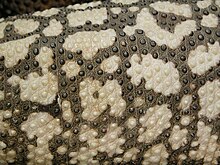Osteoderm

Closeup of a Helodermatid's skin, revealing the osteoderms
Osteoderms are bony deposits forming scales, plates or other structures based in the dermis. Osteoderms are found in many groups of extant and extinct reptiles and amphibians, including lizards, crocodilians, frogs, temnospondyls (extinct primitive amphibians), various groups of dinosaurs (most notably ankylosaurs and stegosaurians), phytosaurs, aetosaurs, placodonts, and hupehsuchians (marine reptiles with possible ichthyosaur affinities).
Osteoderms are uncommon in mammals, but have occurred in many xenarthrans (armadillos and the extinct glyptodonts and ground sloths). Osteoderms have clearly evolved independently in many different lineages[citation needed], and these varied structures should be thought of as anatomical analogues, not homologues, and do not necessarily indicate monophyly. In many cases, osteoderms may function as defensive armor. Osteoderms are composed of bone tissue, and are derived from a scleroblast neural crest cell population during embryonic development of the organism. The scleroblastic neural crest cell population shares some homologous characteristics associated with the dermis.[1]
The osteoderms of modern crocodilians are heavily vascularized, and can function as both armor and as heat-exchangers, allowing these large reptiles to rapidly raise or lower their temperature. Another function is to neutralize acidosis, caused by being submerged under water for longer periods of time and leading to the accumulation of carbon dioxide in the blood. The calcium and magnesium in the dermal bone will release alkaline ions into the bloodstream, acting as a buffer against acidification of the body fluids.[2]
See also
- Scute
References
^ Vickaryous, Matthew K.; Sire, Jean-Yves (2009-04-01). "The integumentary skeleton of tetrapods: origin, evolution, and development". Journal of Anatomy. 214 (4): 441–464. doi:10.1111/j.1469-7580.2008.01043.x. ISSN 1469-7580. PMC 2736118. PMID 19422424..mw-parser-output cite.citationfont-style:inherit.mw-parser-output .citation qquotes:"""""""'""'".mw-parser-output .citation .cs1-lock-free abackground:url("//upload.wikimedia.org/wikipedia/commons/thumb/6/65/Lock-green.svg/9px-Lock-green.svg.png")no-repeat;background-position:right .1em center.mw-parser-output .citation .cs1-lock-limited a,.mw-parser-output .citation .cs1-lock-registration abackground:url("//upload.wikimedia.org/wikipedia/commons/thumb/d/d6/Lock-gray-alt-2.svg/9px-Lock-gray-alt-2.svg.png")no-repeat;background-position:right .1em center.mw-parser-output .citation .cs1-lock-subscription abackground:url("//upload.wikimedia.org/wikipedia/commons/thumb/a/aa/Lock-red-alt-2.svg/9px-Lock-red-alt-2.svg.png")no-repeat;background-position:right .1em center.mw-parser-output .cs1-subscription,.mw-parser-output .cs1-registrationcolor:#555.mw-parser-output .cs1-subscription span,.mw-parser-output .cs1-registration spanborder-bottom:1px dotted;cursor:help.mw-parser-output .cs1-ws-icon abackground:url("//upload.wikimedia.org/wikipedia/commons/thumb/4/4c/Wikisource-logo.svg/12px-Wikisource-logo.svg.png")no-repeat;background-position:right .1em center.mw-parser-output code.cs1-codecolor:inherit;background:inherit;border:inherit;padding:inherit.mw-parser-output .cs1-hidden-errordisplay:none;font-size:100%.mw-parser-output .cs1-visible-errorfont-size:100%.mw-parser-output .cs1-maintdisplay:none;color:#33aa33;margin-left:0.3em.mw-parser-output .cs1-subscription,.mw-parser-output .cs1-registration,.mw-parser-output .cs1-formatfont-size:95%.mw-parser-output .cs1-kern-left,.mw-parser-output .cs1-kern-wl-leftpadding-left:0.2em.mw-parser-output .cs1-kern-right,.mw-parser-output .cs1-kern-wl-rightpadding-right:0.2em
^ "Antacid armour key to tetrapod survival". ABC Science. Retrieved 6 March 2017.
- Carroll, R. L. 1988. Vertebrate Paleontology and Evolution. W. H. Freeman and Company.
This reptile article is a stub. You can help Wikipedia by expanding it. |
This vertebrate anatomy-related article is a stub. You can help Wikipedia by expanding it. |
